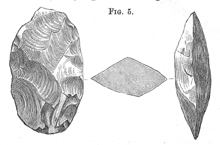|
remarkably even and uniform. Another flint of
considerable interest I had the good fortune to find in 1879. This is an
example of a class of flints termed "ovoid-flints." My
specimen (Fig. 5) is 3 inches long and 2 inches wide, and is chipped to
a thin and tolerably regular edge all round. It is worked into an
oviform shape on both sides with a considerable amount of care.

|
|
Upwards of thirty specimens of
"thumb-flint," or "scrapers," have from time to time
been picked up. They are of various sizes from 1 inch to 2 inches
across, and are of as many shapes and varieties of workmanship. Most of
them have been greatly damaged by the plough-share and the spade, but
others, from their appearance, do not seem to have been broken recently,
but indicate that they were worn out and thrown away as useless by the
men who made or used them.
The purpose for which they were used may have been such as
to render them useless after a short time; such, for instance, as the
fashioning of wooden bowls or plates, or the making of articles of horn,
bone, jet, or even the softer kinds of stone. They were probably used
for several other purposes, such as scraping skins which were undergoing
the process of tanning, and |